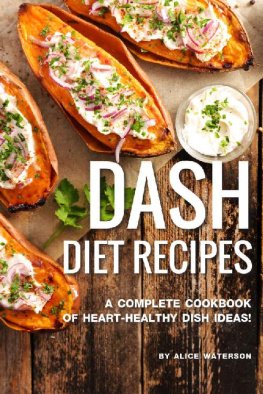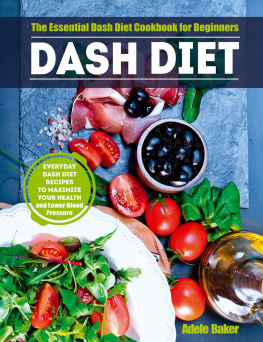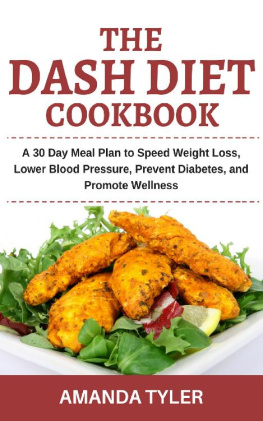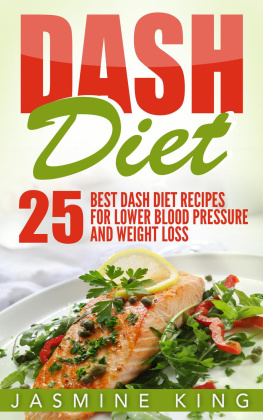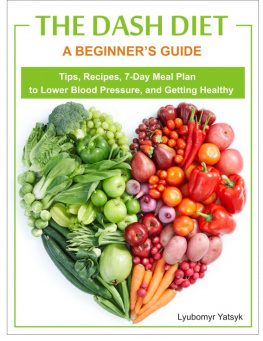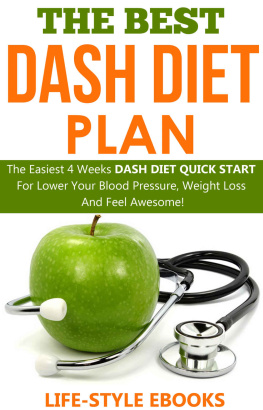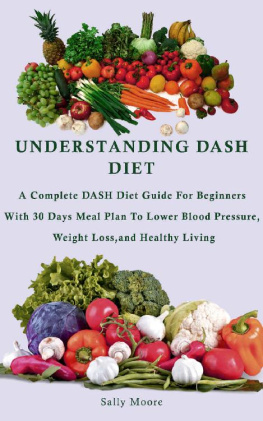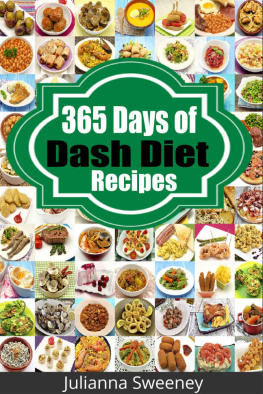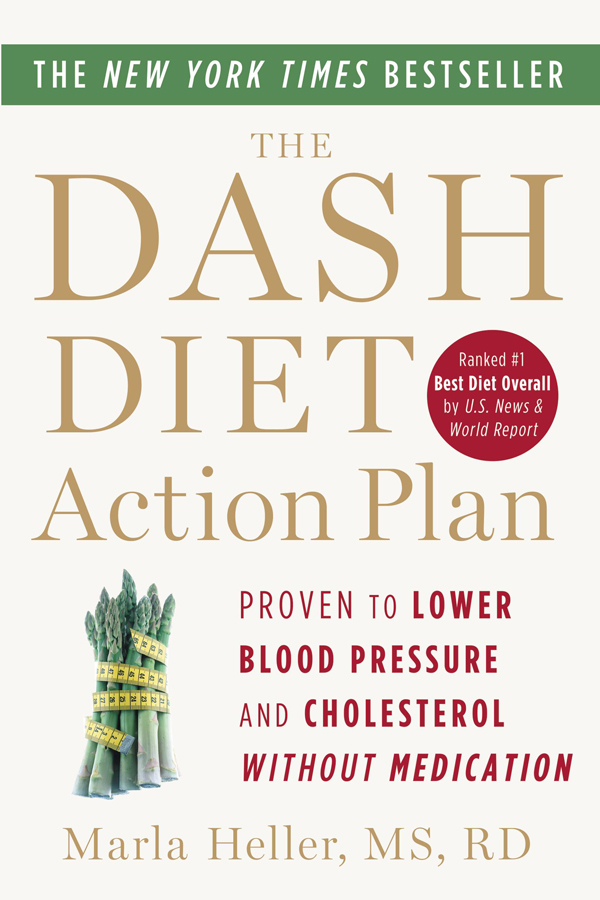Thank you for buying this ebook, published by Hachette Digital.
To receive special offers, bonus content, and news about our latest ebooks and apps, sign up for our newsletters.
The nutrition advice in this book is based on the DASH diet, developed in the National Institutes of Health studies. It is not intended to replace advice or treatment provided by your physician. Please consult with your physician before making any dietary changes. The author disclaims any liability directly or indirectly from The DASH Diet Action Plan.
Nutritional analyses on the menus in this book were obtained using Nutritionist Pro, First DataBank.
Copyright 2007 by Marla Heller, MS, RD
Cover design by Tom McKeveny
Cover photo Kiefer/PhotoCuisine/Corbis
Cover copyright 2014 by Hachette Book Group, Inc.
All rights reserved. In accordance with the U.S. Copyright Act of 1976, the scanning, uploading, and electronic sharing of any part of this book without the permission of the publisher constitute unlawful piracy and theft of the authors intellectual property. If you would like to use material from the book (other than for review purposes), prior written permission must be obtained by contacting the publisher at permissions@hbgusa.com. Thank you for your support of the authors rights.
Grand Central Life & Style
Hachette Book Group
1290 Avenue of the Americas
New York, NY 10104
hachettebookgroup.com
twitter.com/grandcentralpub
First ebook edition: December 2014
Grand Central Life & Style is an imprint of Grand Central Publishing.
The Grand Central Life & Style name and logo are trademarks of Hachette Book Group, Inc.
The Hachette Speakers Bureau provides a wide range of authors for speaking events. To find out more, go to www.hachettespeakersbureau.com or call (866) 376-6591.
The publisher is not responsible for websites (or their content) that are not owned by the publisher.
ISBN 978-1-4555-1281-2
E3
The DASH Diet Weight Loss Solution:
2 Weeks to Drop Pounds, Boost Metabolism, and Get Healthy
The DASH Diet Action Plan:
Proven to Lower Blood Pressure and Cholesterol without Medication
The Everyday DASH Diet Cookbook:
Over 150 Fresh and Delicious Recipes to Speed Weight Loss, Lower Blood Pressure, and Prevent Diabetes
To my husband, Richard
W hen you were a child, your grandmother probably told you to drink your milk, eat your fruits and vegetables, and go outside and play. This is still great advice, and shows that our fundamental ideas of good nutrition hold up over time.
The Dietary Approaches to Stop Hypertension dietbetter known as the DASH dietis a new healthy eating plan that has been proven to help reduce blood pressure and cholesterol. It is based on the same great advice that our grandmothers generation lived bywhich, somehow, Americans seem to have forgotten. The DASH diet is grounded in healthy eating principles that, in addition to lowering blood pressure, are associated with lower risk of heart disease, stroke, and cancer. It can support reaching and maintaining a healthy weight. No conflicting information, no magic combinations, no forbidden foodsjust fabulous healthy eating.
The 2010 Dietary Guidelines for Americans recommend the DASH eating plan for everyone. And, the DASH diet formed the basis for MyPlate dietary guidelines from the USDA.
When you follow the DASH Diet Action Plan, you will eat lots of fruits and vegetables, combined with low-fat dairy foods, lean meat, poultry, fish, some nuts and beans, and grains. The plan is low in saturated fat and cholesterol; has a moderate amount of protein; and is rich in vitamins, minerals, and fiber.
Understanding Blood Pressure
More than sixty-eight million Americans have high blood pressure and another seventy million have prehypertension. It is the leading cause of heart attacks and strokes. If your blood pressure goes too low you may feel lightheaded. If it goes too high there might not be any symptoms, or it could trigger a stroke. If blood pressure remains high, it can lead to congestive heart failure, kidney failure, hardening of the arteries, stroke, and other complications.
What is a diet?
A diet is not just a plan for losing weight; a diet refers to the way we eat. Any eating pattern is a diet.
You might not have learned that you had high blood pressure until your physician detected it in a routine physical exam. You probably had no symptoms. You may not be able to detect that your blood pressure is high unless you check it on a regular basis. Since you often dont feel that anything is wrong, you might not keep it as well controlled as your physician would like. This is one of the reasons hypertension has been called the silent killer.
Blood pressure is composed of two numbers. Systolic is the top number and diastolic is the bottom number. If your blood pressure is 120 over 80, the 120 is the systolic pressure and 80 is the diastolic. Blood pressure is considered to be high (hypertension) if the systolic is higher than 140 or if the diastolic is more than 90. (Your physician might consider you to have high blood pressure at slightly lower numbers if there are other medical complications to consider.)
Blood Pressure Definitions
Normal: Systolic 90-119 and diastolic 60-79.
Prehypertension: Systolic 120-139 and/or diastolic 80-89.
Stage I Hypertension: Systolic 140-159 and/or diastolic 90-99.
Stage II Hypertension: Systolic 160 or higher and/or diastolic 100 or greater.
A new category of prehypertension has been identified as systolic blood pressure between 120 and 139, or diastolic between 80 and 89. When blood pressure is high, it forces the heart to beat harder to move the blood and can cause premature hardening or other damage to the arteries.
High blood pressure is not an equal opportunity disease. Men are at higher risk of complications than women with the same blood pressure. African Americans and older people are also at higher risk than other ethnic groups and younger people with the same blood pressure readings. This makes it even more important to control hypertension.
Blood pressure can be high for unknown reasons, which is called essential hypertension. It can also be elevated due to another disease process, such as overproduction of certain hormones or kidney disease. This is called secondary hypertension since it occurs secondary to another disease.
Why DASH?
Research sponsored by the National Institutes of Health (NIH) has shown that this healthy diet can lower blood pressure as well as medication. Results are quick, with many people seeing lower blood pressure in only fourteen days with the DASH diet. Adding weight loss (when needed), exercise, and other healthy lifestyle choices further improve the blood pressure benefits. Why does the DASH diet make such a difference? And how does it differ from the average American diet?


